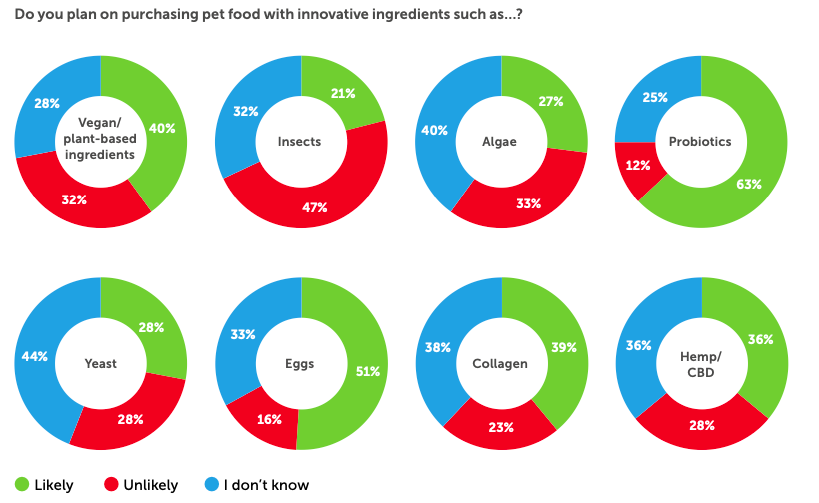Pet food ingredients: What do pet owners actually prefer?

Results from a survey reveal pet owners’ preferences for ingredients. From the health benefits they most desire to the types of food products they plan to buy.
Pet food and treat manufacturers continuously try to differentiate themselves, by adding extra ingredients to their products, and by focusing on different health benefits in their marketing and packaging. But what are the things that resonate most with consumers?
To find out, we partnered with Yummypets and surveyed 762 pet owners across Canada (24%), France (28%), the UK (21%) and the US (28%).
Popular health benefits
Pet parents often look for specific benefits when buying pet food. But which are the most popular?
What owners look for in particular are ingredients and food products that help with their pet’s gut health and digestion. 55% of the consumers name this as one of the 3 main benefits that innovative ingredients should bring to their pet. Closely following in popularity is a boost to the pet’s immune system (47% of pet owners), strengthening joints and bones (46%), and supporting the pet’s heart and cardiovascular health (40%).
Benefits like help with weight control (34%) and brightening the pet’s skin and coat (24%) are looked for less often in pet food. The least important benefits include protecting the pet’s eyesight, with only 9% of the owners indicating this as important. Ingredients that boost a pet’s mental health (10%) and ingredients that boost a pet’s brain and cognitive health (18%) complete the bottom of the list.
While there aren’t any significant differences between age groups or countries, pet owners living in big cities do indicate more often that they like ingredients that help with weight control. People who live in the countryside think that ingredients that strengthen their pet’s joints and bones are slightly more important.
How ingredients affect purchasing
We asked pet owners how likely it is that they’ll buy pet food with different types of ingredients (see charts).
The most popular ingredient is probiotics, with 63% of pet owners indicating that they’re likely to buy pet food products that contain them.
Completing the top 4 of the most popular ingredients are eggs (51%), plant-based or vegan ingredients (40%) and collagen (39%).
Insect ingredients evoke the biggest negative response, with 47% of consumers saying they won’t be buying insect-based products. American consumers are slightly less open to trying insects, while UK consumers are most likely to buy them.
The 3 ingredients that consumers are the most unsure about – when it comes to buying products that contain them – are yeast, collagen and algae. This suggests that the benefits they provide might not be clear to consumers, or that they just don’t find the ingredients particularly appealing.
Upcycled ingredients
Using upcycled ingredients is increasingly popular among pet food and treat brand manufacturers. But not all consumers know what they are. Some 66% of pet owners in this survey indicate that they’re not familiar with the term. Consumers in the UK are the most familiar with this type of ingredient – US pet owners the least. Younger generations are also more likely to know the term than older generations.
A mere 7% of the respondents indicate that they’re already feeding their pet with upcycled ingredients. A whopping 54% would be willing to try it. For 24% of them, learning more about it would be the first step. Only 7% are not interested in the concept at all.
Superfoods: classic versus exotic
Pet owners seem less inclined to feed their pets with slightly ‘exotic’ superfoods. Instead, they are more comfortable with well-known, traditional superfoods. For example, consumers are most open to buying pet food containing carrots (66%), sweet potatoes (58%), pumpkin (51%), spinach (49%) or blueberries (47%).
At the opposite end of the scale, superfoods that don’t score well with pet owners include fermented vegetables (23%), goji berries (27%) and pomegranate (29%). Somewhere in the middle are turmeric (38%), blackberries (35%), kale (34%), krill/shellfish (33%) and coconut (31%).
Human grade?
There is some debate about whether or not pet owners understand what human-grade pet food actually means. So we decided to ask.
It seems like people do, with 35% of consumers finding it very important that their pet food is human grade, and 42% ‘somewhat important’. Only a tiny minority (7%) don’t find it important. 15% of the respondents are unsure about how important it really is – and perhaps what the term really means.
Non-traditional protein preferences
Besides pet food and treat products with traditional proteins like beef and chicken, how willing are pet parents to feed their pet with food or treats containing other proteins? It turns out that they’re very much open to it. Only 19% prefer to stick to the traditionally used proteins.
The top 5 proteins that people find the most acceptable are eggs (52%), venison (44%), sunflower seeds (41%), quinoa (39%) and algae (33%). Insects (31%), elk (30%) and water buffalo (30%) are in the middle of the preference list. Ostrich (27%) and alligator (23%) are at the bottom of this particular list.
US pet owners are most open to elk, water buffalo and alligator, and least open to algae and insects. French consumers are not really a fan of alternative meat protein like venison, elk, water buffalo, ostrich or alligator. UK consumers are most likely to feed insect-based products.
Personalized pet food subscriptions
Companies like Tails.com and NomNomNow have popularized custom-made pet food, tailored specifically to a pet and its needs. But exactly how popular are services like these?
Around 8% of respondents indicate that they currently use this type of service. Another 8% have used one in the past but not anymore. While 27% of respondents clearly state that they’re not interested in these types of services, 35% indicate that they do want to give one a try in the coming months.
There are some generational differences between pet owners and their interest in personalized pet food. Older generations are more likely to not be interested in these services, while 25-34 year-olds are most likely to try one out in the near future.
There’s also a geographical difference. Pet parents from the UK are most likely to have tried a service like this in the past, but have stopped using it now. Canadians, on the otherhand, are the least interested in this type of service and also use it the least.
Planned category purchases
What are the categories that pet owners plan on buying in the next 6 months?
- Freeze-dried and frozen pet food
- These 2 food categories are at the bottom of people’s shopping lists. 48% of pet owners indicate that it’s unlikely they’ll buy frozen pet food. 37% say that they won’t buy freeze-dried food. Freeze-dried is also the category with the largest group of consumers (31%) who don’t know whether they’ll buy this type of pet food.
- Toppers
- With 49% of pet owners planning on buying toppers, this is one of the top 3 categories. UK consumers are most likely to buy toppers, while French consumers are the least likely to.
- Fish oils
- The category in second position for planned purchases is fish oil, with 51% of pet owners likely to buy it in the next 6 months.
- Pet supplements
- Pet supplements come out on top, with 62% of people indicating that they’re likely to buy them. American consumers are more likely to be seen in this category, while here again French consumers are the least likely to buy these products.


